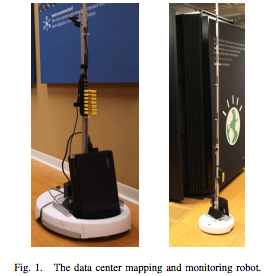Robot Optimizes Datacenter Cooling
Chances are that new Roomba vacuum lookalike in your datacenter is not really a vacuum, but it is based on the same iRobot platform.
 IBM developed the autonomous robot to map temperature and humidity levels in datacenters. IBM Data Center Efficiency Consultant Patrick Coico shows off the device in a short video.
IBM developed the autonomous robot to map temperature and humidity levels in datacenters. IBM Data Center Efficiency Consultant Patrick Coico shows off the device in a short video.
Just like the Roomba, the robot is able to navigate never-before-seen environments. After being set down on any open tile on the datacenter floor, it first locates a wall and then works from the perimeter in, all the while taking temperature and humidity readings until it has mapped the entire area. This data is fed to IBM software in real-time and turned into an efficiency report.
Coico explains the information helps datacenter managers "figure out where they need to change the delivery of the air, the cooled air, to the servers. A lot of the time, the cool air is wasted because it doesn't get to the inlets of the servers. So we try to identify areas where they need to take action to redirect the air to more efficiently use it."
Once the robot has mapped a datacenter, it can continue to monitor for hot spots and other anomalies using intelligent sampling.
The entire design process is laid out in this IBM Research paper. The robot was built on top of the iRobot Create robotic research platform, which employs a robust, low-cost mobile chassis with a limited number of on-board sensors. The design team added a USB webcam, a laptop computer and a custom interface for sensing temperature and humidity. Create's on-board 8-bit processor handles motion commands. The temperature and humidity sensors were attached to a 6 1/2 foot tall aluminum pole mounted vertically to the robot base. The sensors are spaced at 1 foot intervals to provide a 3rd dimension of measurement that extends just above the top of the 76-inch racks.
The prototype robot was constructed for less than $700. Initial scans are generally completed in under an hour. The ability to frequently measure key environmental metrics helps ensure that all equipment receives the optimal amount of cooling, which reduces energy consumption and keeps equipment running properly.










